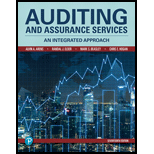
Auditing And Assurance Services
17th Edition
ISBN: 9780134897431
Author: ARENS, Alvin A.
Publisher: PEARSON
expand_more
expand_more
format_list_bulleted
Concept explainers
Question
Chapter 15, Problem 25.3MCQ
To determine
Which of the following tests would an auditor most likely use attribute sampling?
Expert Solution & Answer
Want to see the full answer?
Check out a sample textbook solution
Students have asked these similar questions
ABC Manufacturing Company produces widgets and has been operating for several years. The company's management team is responsible for preparing and monitoring the company's budget to ensure that it stays on track and achieves its financial objectives. ABC Manufacturing Company has recently completed its fiscal year. Management has compiled the planning budget and actual results for the year and has found that the company's actual performance fell short of its budgeted expectations.
Management wants your help in gleaning extra information from what we have. The budget and actual results are as follows:
Planning budget
Sales revenue
$5,000
Direct materials
1,000
Direct labor
1,500
Manufacturing overhead
750
Selling and administrative expenses
1,500
Profit
$250
Actual results
Sales revenue
$4,500
Direct materials
1,200
Direct labor
1,100
Manufacturing overhead
900…
You gave me unhelpful so i am also gave you unhelpful.if you will not give unhelpful then also i will not give unhelpful.
what is accoun?
Kling Company was organized in December Year 1 and began operations on January 2, Year 2. Prior to the start of operations, it incurred the following costs:
Costs of hiring new employees
Attorney's fees in connection with the organization of the company
Improvements to leased offices prior to occupancy (10-year lease)
Costs of pre-opening advertising
Required:
1. What amount should the company expense in Year 1?
600
$3,000
12,000
6,000
5,000
Chapter 12 Homework assignment take frame
Start-Up Costs
What amount should the company expense in Year 2?
+A
$
Chapter 15 Solutions
Auditing And Assurance Services
Ch. 15 - Prob. 1RQCh. 15 - Prob. 2RQCh. 15 - Prob. 3RQCh. 15 - Prob. 4RQCh. 15 - Prob. 5RQCh. 15 - Prob. 6RQCh. 15 - Prob. 7RQCh. 15 - Prob. 8RQCh. 15 - Prob. 9RQCh. 15 - Prob. 10RQ
Ch. 15 - Prob. 11RQCh. 15 - Prob. 12RQCh. 15 - Prob. 13RQCh. 15 - Prob. 14RQCh. 15 - Distinguish between the TER and the CUER. How is...Ch. 15 - Prob. 16RQCh. 15 - Prob. 17RQCh. 15 - Prob. 18RQCh. 15 - Prob. 19RQCh. 15 - Prob. 20RQCh. 15 - Prob. 21RQCh. 15 - Prob. 22RQCh. 15 - Prob. 23.1MCQCh. 15 - Prob. 23.2MCQCh. 15 - Prob. 23.3MCQCh. 15 - Prob. 24.1MCQCh. 15 - Prob. 24.2MCQCh. 15 - Prob. 24.3MCQCh. 15 - Prob. 25.1MCQCh. 15 - Prob. 25.2MCQCh. 15 - Prob. 25.3MCQCh. 15 - Prob. 26.1MCQCh. 15 - Prob. 26.2MCQCh. 15 - Prob. 26.3MCQCh. 15 - Prob. 27DQPCh. 15 - Prob. 28DQPCh. 15 - Prob. 30DQPCh. 15 - Prob. 31DQPCh. 15 - Prob. 32DQPCh. 15 - Prob. 36DQPCh. 15 - Prob. 37DQPCh. 15 - Prob. 38C
Knowledge Booster
Learn more about
Need a deep-dive on the concept behind this application? Look no further. Learn more about this topic, accounting and related others by exploring similar questions and additional content below.Similar questions
arrow_back_ios
SEE MORE QUESTIONS
arrow_forward_ios
Recommended textbooks for you
 Auditing: A Risk Based-Approach (MindTap Course L...AccountingISBN:9781337619455Author:Karla M Johnstone, Audrey A. Gramling, Larry E. RittenbergPublisher:Cengage Learning
Auditing: A Risk Based-Approach (MindTap Course L...AccountingISBN:9781337619455Author:Karla M Johnstone, Audrey A. Gramling, Larry E. RittenbergPublisher:Cengage Learning Auditing: A Risk Based-Approach to Conducting a Q...AccountingISBN:9781305080577Author:Karla M Johnstone, Audrey A. Gramling, Larry E. RittenbergPublisher:South-Western College Pub
Auditing: A Risk Based-Approach to Conducting a Q...AccountingISBN:9781305080577Author:Karla M Johnstone, Audrey A. Gramling, Larry E. RittenbergPublisher:South-Western College Pub

Auditing: A Risk Based-Approach (MindTap Course L...
Accounting
ISBN:9781337619455
Author:Karla M Johnstone, Audrey A. Gramling, Larry E. Rittenberg
Publisher:Cengage Learning

Auditing: A Risk Based-Approach to Conducting a Q...
Accounting
ISBN:9781305080577
Author:Karla M Johnstone, Audrey A. Gramling, Larry E. Rittenberg
Publisher:South-Western College Pub